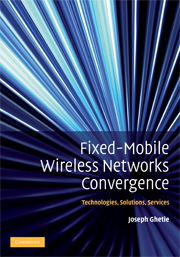Book contents
- Frontmatter
- Contents
- Disclaimer
- How the Book is Organized
- List of Figures
- List of Tables
- Preface
- Acknowledgments
- Acronyms
- Part I Wireless Communications: Networking and Management
- Part II Cellular Mobile Radio Networking and Management
- 4 Cellular Mobile Radio Networking
- 5 Cellular Mobile Radio Networks Management and Services
- Part III Fixed Wireless Technologies: Networking and Management
- Part IV Fixed Wireless Cellular Mobile Networks Convergence and Integration
- Part V Fixed Wireless Cellular Mobile Networks Convergence: Standardized Networking Solutions
- Part VI Fixed-Mobile Convergence Services, Industry Trends, and Implementation Issues
- References
- Index
4 - Cellular Mobile Radio Networking
from Part II - Cellular Mobile Radio Networking and Management
Published online by Cambridge University Press: 21 August 2009
- Frontmatter
- Contents
- Disclaimer
- How the Book is Organized
- List of Figures
- List of Tables
- Preface
- Acknowledgments
- Acronyms
- Part I Wireless Communications: Networking and Management
- Part II Cellular Mobile Radio Networking and Management
- 4 Cellular Mobile Radio Networking
- 5 Cellular Mobile Radio Networks Management and Services
- Part III Fixed Wireless Technologies: Networking and Management
- Part IV Fixed Wireless Cellular Mobile Networks Convergence and Integration
- Part V Fixed Wireless Cellular Mobile Networks Convergence: Standardized Networking Solutions
- Part VI Fixed-Mobile Convergence Services, Industry Trends, and Implementation Issues
- References
- Index
Summary
Cellular Mobile Radio Communications Concepts
In the first chapter we provided an extensive introduction to wireless communications. Major aspects such as general models for wireless communications, architectural components, and networks classification were introduced. We have also discussed, mainly at the level of acronyms, many of the elements that constitute the complex world of wireless communications. This was done in the context of the even larger legacy wired world. Key to wireless communications is the wireless link established between transmitter and receiver. The type of this link will determine the kinds of wireless communications. In this section we will limit analysis to terrestrial mobile cellular radio networks that, in simple terms, are the radio links established between Mobile Stations (MS) such as handsets and the Basic Transmission Stations (BTS).
Initially, the approach to mobile radio was the same as that in radio or television broadcasting, where a BTS was placed at the highest point of the desired area to be covered. As the number of mobile users increased, congestion eventually occurred because of the limited available spectrum. To assure that frequencies can be reused across geographical regions, mobile communication uses the concept of individual micro cellular radio systems. The cells can be created by earth-based radio tower transmitters/receivers or by satellite footprints. Clusters of 7 terrestrial cells provide an area coverage and separation of commonly used groups of frequencies. The number of total channels supported, hence the network capacity, will be determined by the number of clusters that are implemented.
- Type
- Chapter
- Information
- Fixed-Mobile Wireless Networks ConvergenceTechnologies, Solutions, Services, pp. 63 - 99Publisher: Cambridge University PressPrint publication year: 2008

